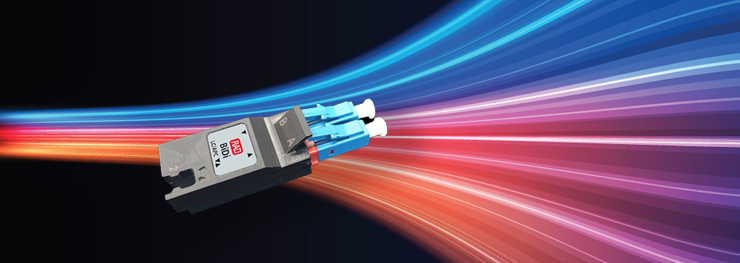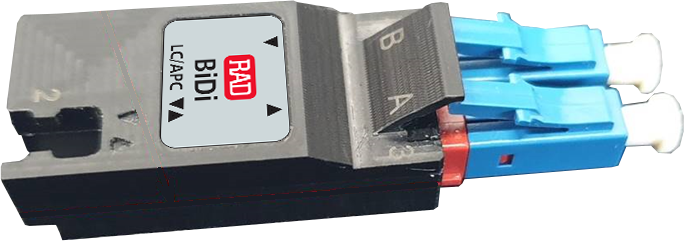
Your Network's Edge®
Blog Post
You are here
How BiDi Transceivers Can Help You Realize 50% Fiber Savings
In the fast-paced world of telecommunications, service providers must keep up with the growing demand for ultra-high bandwidth. As fiber owners, they are tasked with meeting the increasing needs of both existing and potential customers while navigating the complexities of the current infrastructure.
The challenge that service providers face is how to optimize their existing network. This can be complicated when they rely on the standard dual-fiber optical transceivers, and try to add more customers without the need for costly and time-consuming measures. This includes trenching additional fiber, deploying technical teams or even considering complex field replacements.
In this blog, we will delve deep into this issue, exploring innovative solutions to address the evolving needs of CSPs and their customers.
What is a BiDi SFP?
Almost all modern optical transceivers utilize two fibers to transmit data between switches, firewalls, servers, routers, etc. The first fiber receives data from network equipment, and the second fiber transmits data to it.
However, transceivers can now both transmit and receive data to and from interconnected equipment through a single optical fiber. This technology has led to the development of bi-directional transceivers, or BiDi transceivers for short.
The primary difference between BiDi transceivers and traditional two-fiber transceivers is that BiDi transceivers are fitted with wavelength division multiplexing (WDM) couplers, also known as diplexers. These combine and separate data transmitted over a single fiber based on light wavelengths. For this reason, BiDi transceivers are also referred to as WDM transceivers.
To work effectively, BiDi transceivers must be deployed in matched pairs, with their diplexers tuned to match the expected wavelength of the intended transmitter and receiver.
For example: If paired BiDi transceivers are being used to connect Device A (upstream) and Device B (downstream), as shown in the figure below, then:
Transceiver A’s diplexer must have a receiving wavelength of 1490nm and a transmit wavelength of 1310nm.
Transceiver B’s diplexer must have a receiving wavelength of 1310nm and a transmit wavelength of 1490nm.
Matched Pair of BiDi Transceivers
By utilizing BiDi SFPs, we effectively managed a portion of the fiber network and utilized additional capacity as required. The patented design allows for a snug fit of the SFP without requiring additional space in the rack.
Passive BiDi Transceivers
RAD has developed the patented BiDi QSP adaptor to solve the issue of making the transition from dual-fiber optical transceivers to single-fiber easy.
RAD’s BiDi QSFP adaptor is a passive, small-factor dual to single fiber adapter that can be plugged into existing SFPs, providing immediate savings for 1G, 10G, 100G, and 200G fiber infrastructure. There is no need to replace the installed SFP, and or encounter interoperability issues. For 1G and 10G SFPs the utilization of RAD’s BiDi QSFP adapter delivers performance with minor range degradations, up to 80 km (50 Mi) for 1G and up to 40 km (25 Mi) for 10G. For 100G QSFPs, RAD’s BiDi is effective up to 25 km (15.5 Mi).
The Benefits for Service Providers Are Twofold
Network Link Capacity Expansion: When network operators build transmission networks, the scale of optical cables is deployed according to expected business volume and fiber core ratio. However, with the continuously increasing number of fiber users in recent years, there is a gradual shortage of optical cable core resources. Reconstructing new optical fibers would require a long construction cycle and prohibitive costs. This can be effectively solved by reducing the number of fibers per customer, realizing the rapid improvement in network link capacity, and saving the cost of network construction in the meantime.
Enhanced Network Link Maintenance: If the fiber link in the single-fiber bidirectional transmission system is unexpectedly interrupted, the maintenance and repair time will be greatly shortened, because the number of optical fibers requiring maintenance and repair is reduced by half compared to traditional dual fiber transmission systems.
Summary
To address the challenge of Increasing network capacity without trenching new fibers, a solution involving the replacement of traditional SFP with BiDi (Bidirectional) capabilities has emerged. However, this switch can potentially cause interop issues and service downtime due to the active nature of SFP devices. Instead, a passive optical device capable of light re-direction and translation from dual-fiber SFP to single-fiber offers a viable solution. This approach doubles fiber capacity without the need for SFP replacement. While BiDi transceivers offer significant cost savings in fiber cabling infrastructure, some service providers may hesitate due to operational constraints. RAD's BiDi QSFP adaptor presents an accessible and cost-effective alternative, ensuring high-performance service delivery up to 200G.
To learn more about RAD’s BiDi QSFP adaptor, read here.
BiDi QSFP28 DD Adaptor


